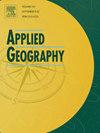食品和饮料行业的环境问题:多变量区域分析
IF 4
2区 地球科学
Q1 GEOGRAPHY
引用次数: 0
摘要
环境问题现在已经成为企业和社会关注的主要问题。事实上,许多公司一直被要求为它们对环境的负面影响负责,而不是因为它们的技术和财务表现而受到赞赏。因此,公司有兴趣向社会证明他们也关心环境福祉,这是理所当然的,为此,他们求助于生态报告。这种披露包括定性和定量数据,用于测量、计算和估计公司运营对环境的影响。与此同时,利益相关者越来越多地以环境报告的形式游说公司在生态责任方面做出重大努力,披露与组织公众形象及其生态相关活动和愿望有关的方面。本研究分析了食品企业的环境报告实践。不同国家和大洲的饮料行业,以确定它们之间可能的差异和相似之处。这为我们提供了对不同机构设置中的组织和环境的更大和更有力的理解。目标人群包括美国、澳大利亚、加拿大和欧盟等发达经济体的公司,以及中国、印度、巴西和墨西哥等发展中经济体的公司。为了便于对结果的解释,这些国家被按大洲分组:欧洲、非洲、亚洲、美洲和大洋洲。食物,饮料行业是人们选择的行业,因为它为人们的生计提供了必不可少的服务,并引起了环境和可持续发展领域学者的关注。此外,先前的证据表明,食物饮料业在很大程度上依赖于自然资源,对环境影响深远。所使用的方法涉及多变量技术,使我们能够分析几个变量的共同行为,并深入了解不同环境指标的表现,因为它们可以按国家和大陆确定。从属于资源利用维度的19个环境变量开始,通过应用逻辑双图获得的结果显示,在整个问题期间,随着这些变量的优先级变化,环境变量显著增加。资源减少政策(RRP)和政策能源效率(PEE)是食品企业最重视的两种方法。饮料行业。在排放方面,趋势与涉及资源利用的趋势相似,随着时间的推移,该领域企业的优先事项发生了显著增长和变化,他们的偏好是政策排放(PE)、减少废物倡议(WRI)和目标排放(TE)。创新维度的亮点涉及以下已成为企业优先事项的变量组:产品影响最小化(PIM),有机产品倡议(OPI),产品环境负责使用(PERUse)和环保产品(EP)。这项研究的下一步是通过X-STATIS分析来探索各大洲之间的差异。欧洲和美国是这项研究的主要焦点。在欧洲,最致力于创新的公司是法国、英国、比利时、荷兰和瑞士;俄罗斯的情况可能正好相反,在这项研究中,俄罗斯的承诺很弱。美国更关注资源利用和排放,涉及的大多数公司都位于美国。本文章由计算机程序翻译,如有差异,请以英文原文为准。
Environmental issues in the food and beverage sector: A multivariate regional analysis
Environmental issues have now become of primary concern for businesses and society alike. Indeed, many companies have been held to account for their negative impact on the environment rather than being appreciated for their technological and financial performance. It therefore stands to reason that companies are interested in proving to society that they are also concerned about environmental wellbeing, and to do so they are resorting to eco-reporting.
This disclosure involves the qualitative and quantitative data that measure, calculate, and estimate the environmental impact of a company's operations. At the same time, stakeholders are increasingly lobbying companies to make major efforts in eco-responsibility in the form of environmental reports, disclosing aspects related to the organisation's public image and its eco-related activities and aspirations.
This research analyses environmental reporting practices involving companies in the food & beverage sector across different countries and continents to identify possible differences and similarities between them. This provides us with a greater and more robust understanding of organisations and the environment in diverse institutional settings. The target population consists of companies in developed economies such as the USA, Australia, Canada, and the EU, and developing ones such as China, India, Brazil, and Mexico. To facilitate the interpretation of the results, the countries have been grouped by continents: Europe, Africa, Asia, America, and Oceania. Food & beverage is the sector of choice because it provides an essential service for people's sustenance and has attracted the attention of scholars in the fields of the environment and sustainability. Moreover, prior evidence shows that the food & beverage sector depends largely on natural resources, with a far-reaching impact on the environment. The methodology used involves multivariate techniques that enable us to analyse the joint behaviour of several variables and provide an insight into how the different environmental indicators perform, as they can be identified by countries and continents.
Beginning with the 19 environmental variables belonging to the dimension of resource use, the results obtained by applying logistic biplot reveal a significant increase over the entire period in question, with changes in priorities across these variables. Resource reduction policy (RRP) and policy energy efficiency (PEE) are the two most highly valued approaches by companies in the food & beverage sector. As regards the dimension of emissions, the trend has been similar to the one involving resource use, with significant growth over time and changes in the priorities of businesses in this sector, with their preferences being policy emissions (PE), waste reduction initiatives (WRI), and target emissions (TE). The highlights in the dimension of innovation involve the following group of variables that have become a corporate priority: product impact minimisation (PIM), organic product initiatives (OPI), product environmental responsible use (PERUse), and environmental products (EP).
The next step in this research has involved exploring the differences across continents by means of an X-STATIS analysis. Europe and America are the study's main focuses. In Europe, the companies with the highest commitment to innovation are France, the United Kingdom, Belgium, the Netherlands, and Switzerland; the opposite may be said of Russia, with a weak commitment in this study. America focuses more on resource use and emissions, with most of the companies involved being located in the US.
求助全文
通过发布文献求助,成功后即可免费获取论文全文。
去求助
来源期刊

Applied Geography
GEOGRAPHY-
CiteScore
8.00
自引率
2.00%
发文量
134
期刊介绍:
Applied Geography is a journal devoted to the publication of research which utilizes geographic approaches (human, physical, nature-society and GIScience) to resolve human problems that have a spatial dimension. These problems may be related to the assessment, management and allocation of the world physical and/or human resources. The underlying rationale of the journal is that only through a clear understanding of the relevant societal, physical, and coupled natural-humans systems can we resolve such problems. Papers are invited on any theme involving the application of geographical theory and methodology in the resolution of human problems.
 求助内容:
求助内容: 应助结果提醒方式:
应助结果提醒方式:


